Ultimate OTS/TFOT Guide (Part 2)

Welcome back BogiDope readers! This is Part 2 of our in-depth report on what OTS is like right now. We covered sections 1-3 last week, and will finish with sections 4-6 today. Enjoy!
Table of Contents
- What is OTS/TFOT?
- Preparing for OTS
- Pre-course Material
- PT Test
- Dorm Manual
- What to bring to OTS
- Packing List
- Important Info Regarding the Packing List
- Required Documents
- Life at OTS
- Main Events During OTS
- Resources
Life at OTS
It’s important to know that EVERYTHING described below will be taught and practiced enough that someone with absolutely no military background or knowledge (i.e. me) will have ample opportunity to learn and perform at an adequate level. You will be clearly told what is expected of you and told exactly how you will be graded for everything. As a pilot candidate, you represent one of the best and brightest the Air Force has to offer. As such, I feel confident in saying that as long as you put forth the effort and do what you’re supposed to be doing, you will be successful at OTS.
Your life at OTS will be very structured and controlled, especially early on. Expect the first few weeks to be filled with constant direction and corrective criticism. In short, you’ll be herded like cattle, your freedoms will be taken away, you will be made uncomfortable, you will be stressed, and you will be tired. There’s not much you can do about it except go along with it. It may sound a bit dreary, because it is, but I assure you it gets significantly better as you progress through the course. You will not ever get hazed, belittled, physically contacted, personally or professionally insulted, or anything of the sort. You will receive verbal constructive criticism to correct the mistakes you will inevitably make.

Throughout most of OTS you’ll have very little control over the specifics of your day-to-day life. Upon arrival to Maxwell AFB, decisions that directly affect your daily life have already been made.
First off, OTS consists of two different training squadrons with different training philosophies: Detachment 12 (Det 12) and the 24th TRS. The squadrons alternate classes and your placement in them is based on timing and luck of the draw. The squadrons have the same course curriculum but have a different cadre of Military Training Instructors (MTIs) and Flight Instructors. Subsequently, each respective squadron goes about its training mission a bit differently than the other. Since you have no influence or control over which training squadron your class will be under, I will leave my specific opinions regarding the squadrons to myself, however, suffice it to say that there are distinctions between the two.
When you arrive at OTS, you will arrive within a specific time-window (ex. 0900-1200) and will in-process as an entire class. None of this will be apparent to you at the time but your class (300+ people) will be slowly broken down into student squadrons (roughly 1/4th of the class), and, eventually, flights (16-ish members each) throughout the day. By the time lunch comes around, you will be with your specific flight. Take a good look around the room and start making introductions because these will be the people you will spend nearly every day with for the next ~9 weeks of your life. You have no influence over what flight you’re in or who you’re with, however your flight can make your time at OTS very enjoyable or it can make the whole school more uncomfortable. It’s in everyone’s best interest to communicate and cooperate so take the lead and get everyone working together. You may or may not have a “recycle” from a previous class in your flight, but if you do, they can be an extremely valuable resource in the first few days and weeks of OTS.
During in-processing day you will be given a small paper booklet called the Officer Training School Manual (OTSMAN) and you will be required to study it at all times throughout the day where you’re not actively participating in standard military training (SMT). The OTSMAN has all of the information you will need to use on a daily basis while at OTS. You will study the OTSMAN daily and eventually take two tests on the material within it. The OTSMAN is constantly changing and being updated so don’t spend too much time looking over past editions, but if you would like to get a basic understanding of what it looks like, you can find it here as well as at the bottom of this article.
There is no “typical” day at OTS as you will always be doing something a bit different as you progress through the curriculum. However, you can expect to wake up between 0400-0430 every day for the first few weeks, including weekends. Eventually, you will be granted 0530 wakeups during the weekend. Cell phones will not be authorized for the first 10 or so days so let your family/friends know accordingly.
You will eat MREs for the first few days, however you will eventually be introduced to the OTS dining facility (DFAC, i.e. cafeteria). The DFAC has very specific procedures that you will be expected to know and follow for every meal throughout your time at OTS. For the first few days, expect to be yelled at and corrected constantly during your time in the DFAC. All of the information you need to know is available in the OTSMAN. Look over the DFAC procedures while you’re standing in formation and it’ll make things go a bit smoother. Expect to have 10 minutes to eat your meal with no talking or looking around. DFAC procedure should remain constant throughout future classes so that would be something to study beforehand if you’re so inclined.
During the first few days of OTS you will be introduced to marching and flight formations. Expect to march, indoors (single file) as well as outdoors, in various sized formations and details everywhere you go for the entire time you are at OTS. If you want to get ahead, read the OTSMAN provided in this article and learn some of the basic terminology and formations, however there will be more than enough time to learn and practice everything. In the interest of full disclosure, this would be a fairly low priority if I were in your shoes.
Here’s an example of what marching in formation looks like:
You can also expect to wear a CamelBak and reflective belt everywhere (outside of the dorms) during your time at OTS. Get comfortable with them because they will be arms-length away from you for the entire time you’re at OTS (my class wore them until 1 hour before families showed up for our Open House during graduation week).
During your time at OTS you will refer to all of your peers as “Officer Trainee [Last Name]” or “OT [Insert Last Name]” and you will give all OTS staff the proper greeting of the day and salute, if appropriate. Greetings of the day are outlined in the OTSMAN, however expect a lot of “Good Morning/Afternoon/Evening Sir/Ma’am” and expect to be held accountable to that standard every day.
OT Roles/Responsibilities
Throughout OTS all students will be assigned various roles and jobs which can be assigned to any OT. Every OT will have at least one job assigned to them within their flight. This document outlines exactly what these jobs are and what they entail.
Below are the current OT jobs:

A few important notes regarding OT jobs:
- All Wing-level OT jobs are picked by staff (exception: you can volunteer for a wing position if you REALLY want one) and typically last 1 week (except Drill and Ceremonies Officer).
- Flight Leader roles are picked by your respective Flight Instructor and typically change every week
- Everyone in your flight will have at least one “Mission Support Group” level job that will remain for the duration of OTS
Highlights:
If I were to do OTS all over again, I would sign up to be the Community Service Officer, the Computer Officer, the Supply Officer, the Safety Officer, or the Graduation Events Officer based on perceived (or actual) workload throughout OTS.
During OTS I was my flight’s Graduation Events Officer (GEO) as well as the Flight Lead and I will provide the official job details as well as elaborate on the specifics of the reality of those jobs below.
GEO:
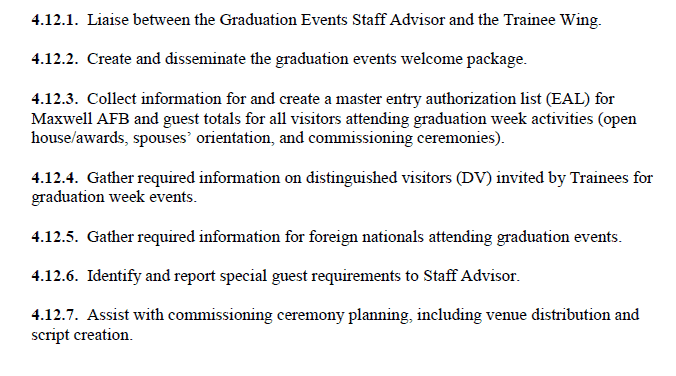
In layman’s terms, the GEO collects all the information of the visitors expected to attend your flight’s graduation week events and submits it to the Wing GEO. My flight had no Distinguished Visitors (DVs) so I did not have to deal with those particulars (Note: We did have some high-level Generals and civilian members attend our parade so it would be extra important for those respective flight GEOs not to mess that up). During Graduation Week you will write the specific script that will be read during your flight’s commissioning ceremony. It’s a bit of a headache during graduation week but other than the visitor list there’s not much for you to do during the first ~7 weeks.
Flight Leader:

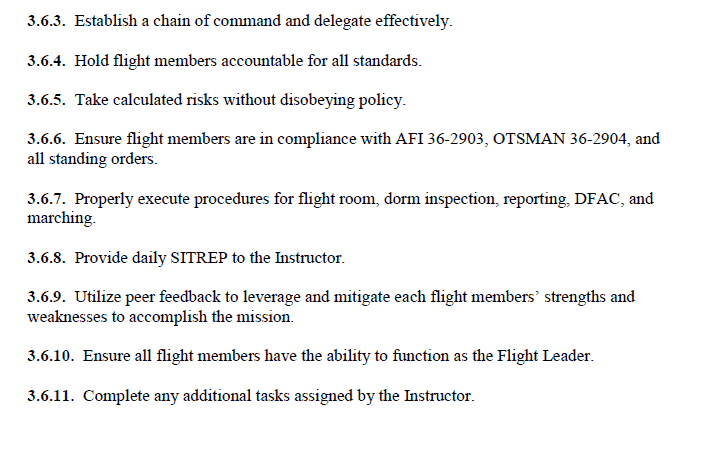
Typically, the Flight Leader position is a week-long and acts as the main liaison between your flight instructor and your flight. For the first 4 flight leaders, this is a graded position; for the last flight leader it is not. I happened to be the lucky (see: unlucky) person who was selected to be the Flight Lead for the last 3 weeks of OTS.
Being a Flight Leader was challenging and fun; it requires you to be aware of everything that goes on in the day-to-day lives of your flight members. You will be responsible for getting everyone in your flight into formation and marching them to the proper location at the correct time, you will coordinate everything applicable with your flight instructor, and you will be responsible for all of the various goings-on that are happening. It requires a lot of communication and effort to do well but it makes the time go by a lot quicker as you will always be busy. If you are chosen for this position, take pride in it and remember that your main job is to take care of your flight mates and make their lives easier while also keeping the flight out of trouble.
Main Events During OTS
During OTS there are a handful of main events that stand out from the remainder of the course. I will detail the following events below: In-processing day, Pennant test, SPT Test 1 & 2, PFB & PFA, Paper 1 & 2, AA1 & 2, LRC, briefing 1 & 2, HELPS, WELPS, ORI 1 & 2, Dorm Inspection 1 & 2, Deployment Week, and Grad Week. With the exception of In-processing day, deployment week, and Graduation week, all of these are graded events.
In-processing day
In-processing is a whirlwind of a day. There’s not much you can prepare for but there are still a few things worth noting. First and foremost, make sure you read your welcome guide and arrive wearing the proper attire (business casual with sneakers) and with your hair in regulation. You will be given a block of time in which you are supposed to arrive on campus, typically 0900-1200, and from the moment you arrive you will be told exactly what to do. Say goodbye to your cell phone because you’ll be directed to turn it off immediately. Expect yelling and lots of direction. You’ll go through various in-processing documents and will be given your OTSMAN and CamelBak.
There will be a lot of standing, single-file, and reading your OTSMAN while waiting for the MTIs to get things organized, but eventually you’ll take all of your luggage across campus to your respective dorm building. At this point, you will pick your dorm room. If you don’t mind having the top bunk then throw your stuff in the first room that you can and move on to the next event, but if I were to do it all over again, I would definitely find a room where the bottom bunk is available. You’re going to have a lot of rushed early-morning wake-ups, and making the jump from the top bunk got sportier than I preferred at 0400. After picking your dorm room you’ll bounce between various briefings for the remainder of the day.
Pennant Test
The pennant test is one of the first graded events of OTS. Your flight will march through campus, led by your Flight Leader, doing a predetermined sequence of drill and facing movements. MTIs will follow you the entire way and debrief you on your performance afterward. That upcoming Friday will be a ceremony where you find out if your flight passed or not. If you fail, the MTIs will pay more attention to your flight (bad) and you will have to retake the test until you pass. Your Flight Leader can make or break it for your flight with this, help them get squared away and confident. If you are not the flight leader, make sure you do your part by being sharp with your movements. You will have more than enough time to practice and perfect this.
SPT 1 & 2
SPT 1 & 2 are taken in your flight room (classroom) on your laptops. They are 20-ish question quizzes on the OTSMAN and you need at least an 80% to pass. I was actually somewhat nervous about the first test as I didn’t know what to expect. The best advice I can give is to just study your OTSMAN cover to cover. SPT 1 was taken 6 days after arriving at OTS. SPT 2 was taken 25 days in and by then you should know the OTSMAN well enough that you don’t have to study for the test.
PFB & PFA
The PFB & PFA are standard Air Force PT tests, taken first thing in the morning. They are administered by the OTS Staff but the reps are counted by other OTs. There’s not much else to say about this; pass and you’re fine, fail and you’re not. The PFB was taken 6 days in and the PFA was taken 41 days in.
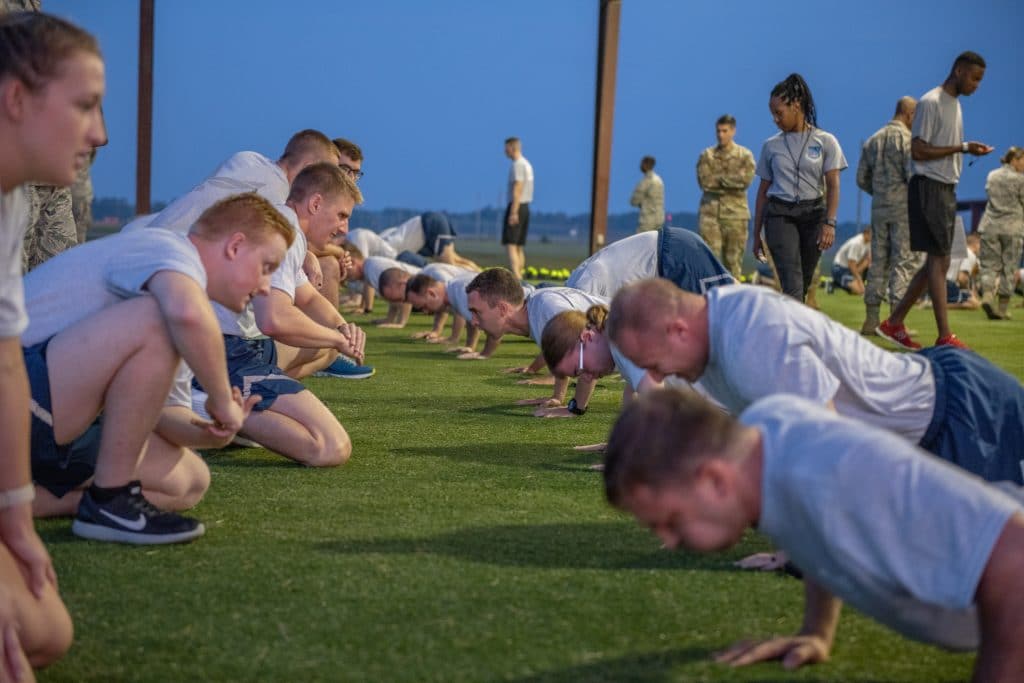
Paper 1 & 2
Paper 1 & 2 are bullet point papers written in accordance with Tongue and Quill. They are frustratingly specific and graded precisely, however once it “clicks” for you it becomes pretty easy to write. I spent a good bit of time writing Paper 1 but spent less than an hour writing Paper 2. These are graduation requirements (80% or greater to pass) and people do fail them and get recycled. These and the academic assessment tests are your highest threat items while at OTS. Pro tip: Keep the MS Word document from Paper 1, make the appropriate formatting adjustments after it gets graded, and use that as a template for Paper 2.
AA1 & 2
Academic Assessment 1 & 2 are scantron based tests, taken as a Wing in Boyd auditorium, on all of the lectured material up until that point. You will know all of the topics that test will cover so make sure to study those. You will have access to an online course manager called AU Canvas where you’ll be able to find all of the PowerPoint slides, readers, and Standards of Behaviors (SOBs) for every lecture/brief at OTS. The SOBs are EXACTLY what you will be tested on. Make sure you focus all of your attention on studying the specifics of those SOBs and you’ll do just fine.
You can find the slides, reader, and SOBs on: AU Canvas>Courses>Home>Curriculum Materials
LRC
The Leadership Reaction Course is a fun and interesting full-day event out behind the PT “paperclip”. The LRC is a course of ~20 challenging obstacles that you have to analyze and complete within a certain time limit. More often than not you will run out of time before finishing. The purpose of the LRC is to surprise you with challenging obstacles to see how you react and lead. I will keep this description intentionally vague to preserve that intention. In short, you will either be leading, participating, or acting as safety during an obstacle. When it is your turn to lead, you will be graded on your performance. You won’t see any of the obstacles prior to “problem solving” them; you and your team will stand with your backs turned to the obstacle and will turn around to analyze and begin problem solving at the sound of a horn. You’ll need to score a 75% or higher on the LRC to pass. This will count as 1 of 2 required leadership positions you’ll have to complete throughout OTS.
Briefing 1 & 2
Briefing 1 & 2 are advocacy briefs you will give to your flight on the same topic your corresponding paper is on (i.e. you will write Paper 1 and then brief your flight on the paper a week or so later). You will have to advocate for a change in current policy and will have between 5-9 minutes to do so, and you will need to create a PowerPoint. If your brief is less than 5 minutes or more than 9 minutes, you will automatically fail. By the time you get around to the briefs you should know the material and be comfortable enough with your flight to stand up and brief them without much of an issue. A handful of the more nervous members of my flight practiced these briefs a few times prior to the actual briefing but I felt comfortable enough simply studying the material and presenting it for the first time during my actual brief. There are some very specific particulars of the briefs so make sure you’re aware of them but other than that these are relatively low-threat events. Briefing 1 was 22 days into OTS and Briefing 2 was the second-to-last graded event, 38 days in.
HELPS
HELPS is a series of “obstacles” and challenges presented to your flight on and around the campus of OTS. It is very similar to the LRC except instead of fixed obstacles, you will be given prompts and riddles that you need to solve in order to complete your mission. Like the LRC, you will either be leading, participating, or acting as a safety and if you are chosen to lead you will be graded on your performance. Only 4 members of my flight were chosen to lead an event.
WELPS
WELPS is the exact same thing as HELPS except it is out in the woods near the compound where you will stay for deployment week. Everyone will get an opportunity to lead a HELPS event. Each event is a little different and challenging in its own way. By this point you will be excited to get off the OTS campus. Keep in mind you will need to pass 2 graded leadership positions in order to graduate so make sure you lock-in and crush these. WELPS was 31 days after in-processing.
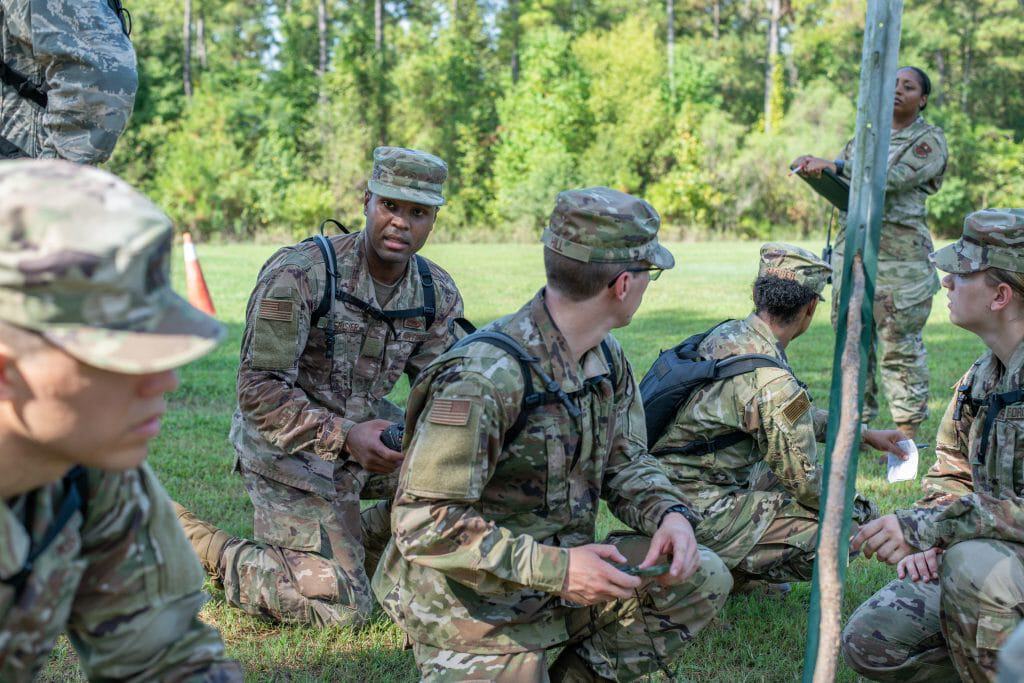
ORI 1 & 2
Open Ranks Inspection 1 & 2 is an event where your flight will put on your dress blues, line up in formation, and get inspected by an MTI. They will be looking for any infraction on your uniform such as dust, wrinkles, scuff marks, improperly placed accouterments, etc. There is a specific sequence of commands given by the flight leader so make sure they know what they’re doing prior to your ORI. The MTIs will pick up on very little discrepancies in your uniform so make sure you and your flight mates look over each other a few times beforehand and you’ll be just fine.
Dorm Inspection 1 & 2
Dorm Inspections are exactly how they sound: the MTIs enter your dorm room and inspect a specific part of it. They will either inspect the common area and beds, the closets, or the dressers. You will need to make sure your room exactly adheres to the Dorm Manual and you will be fine. We had some people get perfect scores on their dorm inspection and others get 15+ demerits. Pay attention to the details and you’ll be just fine. You need to pass at least 1 dorm inspection to graduate. Some people had to get their dorm inspected 3 or 4 times before they passed but typically you will only receive 2.
Deployment Week
Deployment week is a week in a compound out in the woods where you will learn some basic room clearing, defensive perimeter, combative, and other techniques. You will leave on a Monday afternoon and return on Friday evening. The first 3 days of Deployment Week will be mostly educational in nature, with the exception of the obstacle course you’ll complete on Day 1, where the last 2 days will be an event called Operation Eagle. During Op Eagle the wing will split up into 3 different “chalks” (teams) and complete a number of missions. During this time your chalk will be responsible for building defensive perimeters, providing security, and going out on missions all while defending from attacks from the OTS staff and other chalks (each chalk will be issued 20-ish airsoft or paintball guns). Everyone will be assigned some sort of job during deployment week and your job will directly affect your participation, or lack thereof, during Op Eagle. If you are looking for the most action, make sure you get a Security Forces job. If you want to do nothing except sit around for two days, pick a logistics or “medical” job. Like anything else, you will get out of this what you put into it. My suggestion is to throw yourself into as many events as you can and you’ll have a good time. Deployment week is the last thing you will do before Graduation Week.
Grad Week
Congratulations, you made it to graduation week! By this point you will probably be completely fed up with OTS and you’ll barely be able to contain your excitement at the prospect of leaving Maxwell to head to your first duty base. Grad week “technically” kicks off at the informal open house but it will certainly feel like Grad week during your official Dining-In ceremony. Dining-In is when everyone will get dressed up in Mess Dress to have your first formal get-together. Colonels and Commandants will speak and there will be some mildly funny jokes told. This may or may not be your first exposure to alcohol since starting OTS and all you really have to do is not make a jerk of yourself and you’ll Commission as an Officer in the World’s Greatest Air Force. Dining-In was fun and all but by that point all I was really looking forward to was finishing the Graduation Parade and commissioning.
The day after Dining-In will be your open house where families are allowed on campus for the first time. You’ll spend the afternoon and early evening with your family before heading back to the dorms. The next day will be your flight’s commissioning ceremony, where you’ll officially FINALLY commission, and the wing awards ceremony. The awards ceremony is an hour-long ceremony where you will find out who is a Distinguished Graduate and other awards.
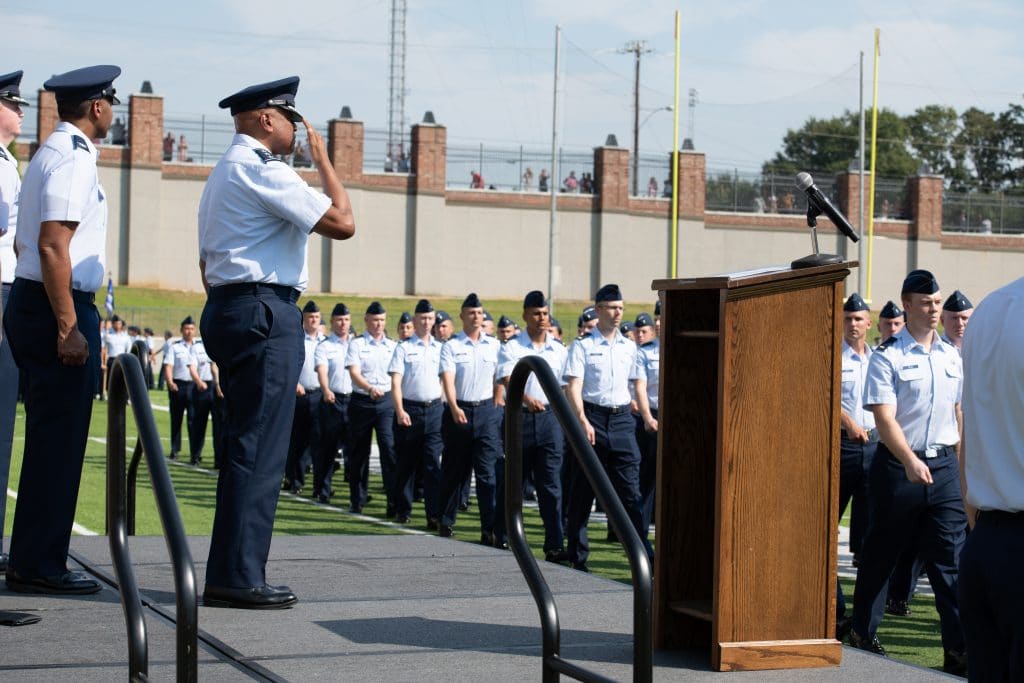
Afterward, you’ll be cut loose to spend some time with your family before the final day of OTS: the Graduation Parade. The Grad parade takes place at roughly 0900 and will take about an hour. You will do some specific marching and will eventually march up front to take the Oath, read by the Commandant of OTS. If your class is lucky, you’ll get a flyover by something cool- such as a two-ship of MiG killing F-15C Eagles. Some classes get luckier than others. Anyways, you’ll say the oath, you’ll hopefully get a flyover from the World’s Greatest Air Superiority Fighter, you’ll throw your hat in the air, and you’ll officially graduate OTS. Congratulations Lieutenant, you did it!
Resources
If you want early access to some of the materials I’ve mentioned, you can download the following:
Welcome Guide:
Tab 1. OTS Welcome Guide (17 Dec 2018)
Dorm Manual:
Dorm Manual_Numbered_11OCT19(updated)
OTSMAN:
OTSMAN 36-2604 Officer Trainee Operating Procedures
<- Back to Part 1 | Part 2
Image Credits:
This post’s featured image is from: https://www.dvidshub.net/image/5783485/ots-godzilla-class-dojo.
In-Processing: https://www.dvidshub.net/image/5656511/godzilla-arrives-maxwell.
PT Test: https://www.dvidshub.net/image/5673703/ots-godzilla-class-pt-test.
WELPS photo: https://www.dvidshub.net/image/5784036/ots-godzilla-class-welps.
The shot of the OTS Gad Parade is from: https://www.dvidshub.net/image/5791542/ots-godzilla-class-graduation.
All other photos were provide by Lt Cooper.







